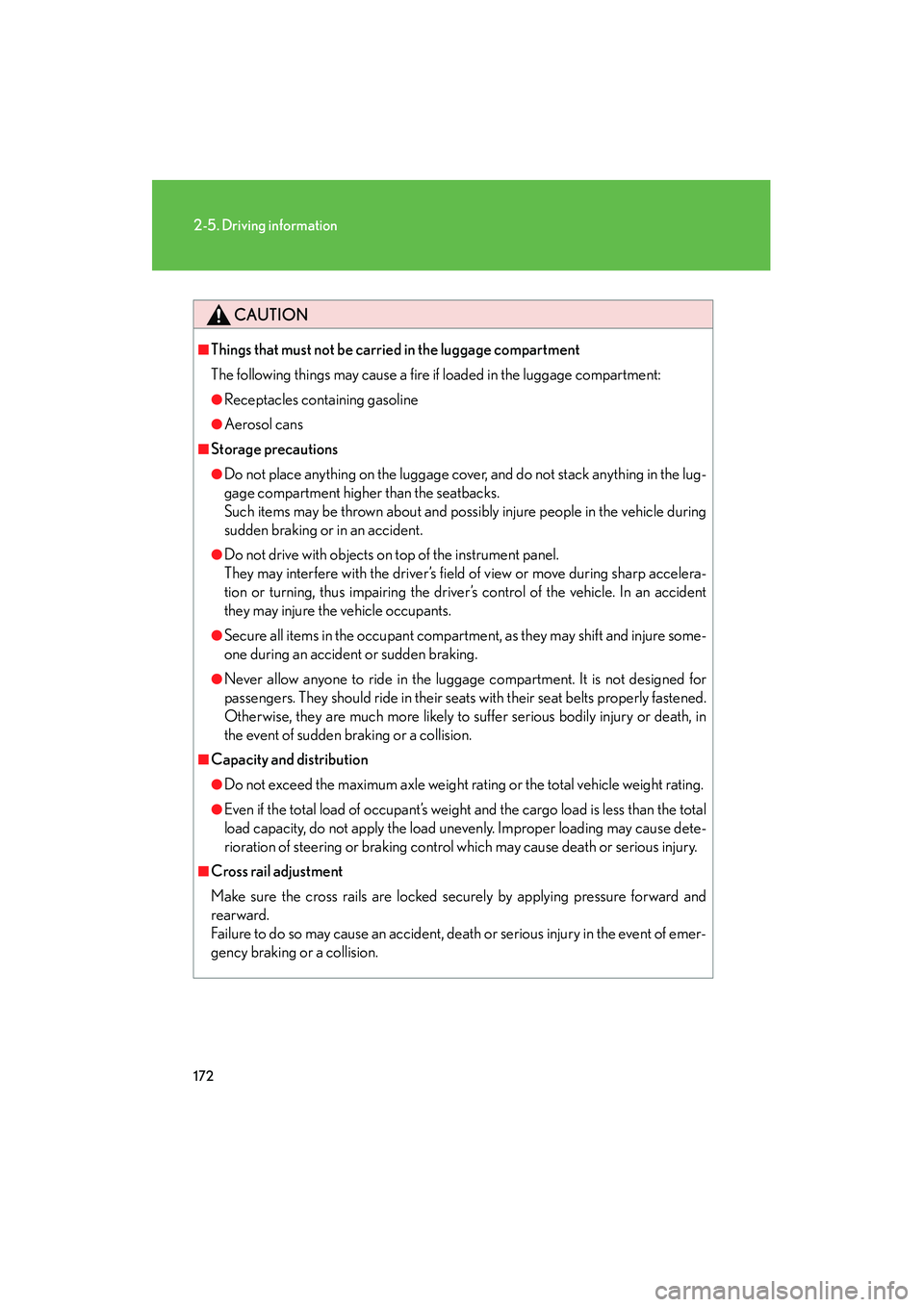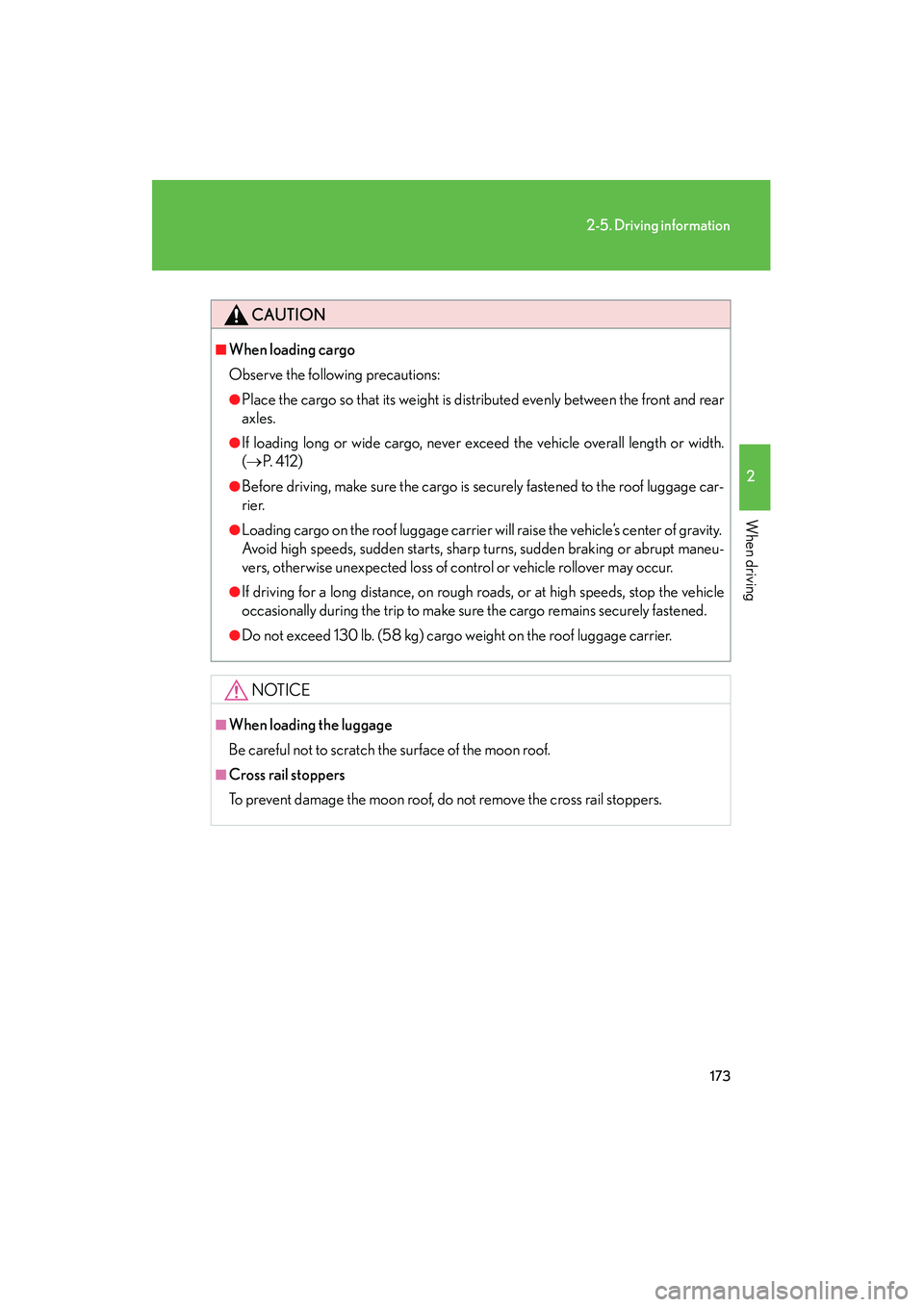Page 107 of 458

106
1-7. Safety information
CAUTION
■When installing a child restraint system
●When a booster seat is installed, always ensure that the shoulder belt is posi-
tioned across the center of the child’s shoulder. The belt should be kept away from
the child’s neck, but not so that it could fall off the child’s shoulder. Failing to do so
may result in death or serious injury in the event of an accident or sudden braking.
●Ensure the belt and tab are securely locked and that the seat belt is not twisted.
●Push and pull the child seat in different directions to be sure it is secure.
●Follow all installation instructions provided by the child restraint system manufac-
turer.
■Do not use a seat belt extender
If a seat belt extender is used when installing a child restraint system, the seat belt
will not securely hold the child restraint system, which could cause death or serious
injury to the child or other passengers in the event of a collision.
■To correctly attach a child restraint system to the anchorages
When using the lower anchorages, be sure that there are no foreign objects around
the anchorages and that the seat belt is not caught behind the child restraint. Make
sure the child restraint system is securely attached, or it may cause death or serious
injury to the child in the event of a sudden stop or accident.
●When installing a child restraint system in
the third center position, set the both seat-
backs to the same angle. Otherwise, the
child restraint system cannot be properly
secured.
Page 108 of 458
107
1-7. Safety information
1
Before driving
CAUTION
■To correctly attach a child restraint system to the anchorages
●When using the lower anchorages, be sure that there are no foreign objects
around the anchorages and that the seat belt is not caught behind the child seat.
Make sure the child restraint system is securely attached, or it may cause death or
serious injury to the child in the event of a sudden stop or accident.
●When using the left side lower anchorages
for the child restraint system, do not sit in
the center seat. Seat belt function may be
impaired, such as being positioned overly
high or loose-fitting, which may result in
death or serious injury in the event of a col-
lision.
Page 117 of 458

116
2-1. Driving procedures
CAUTION
■When taking a nap in the vehicle
Always turn the engine off.
Otherwise, you may accidentally move the shift lever or depress the accelerator
pedal, which could cause an accident or fire due to engine overheating. Addition-
ally, if the vehicle is parked in a poorly ventilated area, exhaust gases may collect
and enter the vehicle, leading to death or a serious health hazard.
■When braking the vehicle
●When the brakes are wet, drive more cautiously.
Braking distance increases when the brakes are wet, and may cause one side of
the vehicle to brake differently than the other side. Also the parking brake may
not securely hold the vehicle.
●If the power brake assist function does not operate, do not follow other vehicles
closely and avoid downhill or sharp turns that require braking.
In this case, braking is still possible, but it will require more force on the pedal than
usual. Braking distance may also increase.
●Do not pump the brake pedal if the engine stalls.
Each push on the pedal uses up the reserve for the power-assisted brakes.
●The brake system consists of 2 individual hydraulic systems: if one of the systems
fails, the other will still operate. In this case, the brake pedal should be depressed
more firmly than usual and braking distance becomes longer.
Do not drive your vehicle with only a single brake system. Have your brakes fixed
immediately.
NOTICE
■While driving the vehicle
Do not use the accelerator pedal or depress accelerator and brake pedals together
to hold the vehicle on a hill.
■When parking the vehicle
Always put the shift lever in “P”. Failure to do so may cause the vehicle to move or
the vehicle may accelerate suddenly if the accelerator pedal is accidentally
depressed.
Page 120 of 458
119
2-1. Driving procedures
2
When driving
■Steering lock release
■Starting the engine using the flat keyPut the key case away when the security indicator light goes out. This
means the engine immobilizer system has turned off.
Start the engine within 60 seconds after the security indicator light goes
off.
■Leak detection pump
Several hours after the engine is turned off, you may hear a sound coming from
underneath the luggage compartment for several minutes. This is normal operation
and does not indicate a malfunction. When starting the engine, the engine switch
may seem stuck in the “LOCK” position. To
free it, turn the key while turning the steering
wheel slightly in either direction.
Remove the flat key from its case. Insert the
key into the engine switch.STEP1
Bring the key case close to the engine switch
within 10 seconds as indicated by an arrow.STEP2
STEP3
STEP4
Page 131 of 458
130
2-2. Instrument cluster
■Indicators
The indicators inform the driver of the operating state of the vehi-
cle’s various systems.
Turn signal indicator
(→ P. 1 2 4 )“RSCA OFF” indicator
(→ P. 8 9 )
Headlight high beam indi-
cator ( →P. 1 3 5 )Downhill assist control
system indicator
(→ P. 1 5 7 )
(U.S.A.)
Headlight indicator
(→ P. 1 3 5 )
(U.S.A.)
Engine oil replacement
reminder light ( →P. 3 8 4 )
(Canada)
Tail light indicator
(→ P. 1 3 5 ) Slip indicator
(→ P. 1 6 0 )
Security indicator
(→ P. 7 0 ) “VSC OFF” indicator
(→ P. 1 4 7 )
Shift position indicators
(→ P. 121)Center differential lock
indicator ( →P. 1 4 7 )
Height control indicator
(→ P. 1 5 0 ) “AIR BAG ON” indicator
(→ P. 9 0 )
Automatic transmission
second start indicator
(→ P. 122)“AIR BAG OFF” indicator
(→ P. 9 0 )
Cruise control indicator
(→ P. 1 4 2 )
*
*
*
*
*
*
*
Page 169 of 458
168
2-5. Driving information
Cargo and luggage
Adjusting the position of cross railsTurn the knobs counterclockwise
to loosen the cross rails.
Take notice of the following information about storage precautions, cargo
capacity and load.
●Stow cargo and luggage in the luggage compartment whenever
possible. Be sure all items are secured in place.
● Be careful to keep the vehicle level. Placing the weight as far for-
ward as possible helps maintain vehicle balance.
● For better fuel economy, do not carry unnecessary weight.
■ Roof luggage carrier
Cross rails
Roof rails
STEP1
Page 173 of 458

172
2-5. Driving information
CAUTION
■Things that must not be carried in the luggage compartment
The following things may cause a fire if loaded in the luggage compartment:
●Receptacles containing gasoline
●Aerosol cans
■Storage precautions
●Do not place anything on the luggage cover, and do not stack anything in the lug-
gage compartment higher than the seatbacks.
Such items may be thrown about and possibly injure people in the vehicle during
sudden braking or in an accident.
●Do not drive with objects on top of the instrument panel.
They may interfere with the driver’s field of view or move during sharp accelera-
tion or turning, thus impairing the driver’s control of the vehicle. In an accident
they may injure the vehicle occupants.
●Secure all items in the occupant compartment, as they may shift and injure some-
one during an accident or sudden braking.
●Never allow anyone to ride in the luggage compartment. It is not designed for
passengers. They should ride in their seats with their seat belts properly fastened.
Otherwise, they are much more likely to suffer serious bodily injury or death, in
the event of sudden braking or a collision.
■Capacity and distribution
●Do not exceed the maximum axle weight rating or the total vehicle weight rating.
●Even if the total load of occupant’s weight and the cargo load is less than the total
load capacity, do not apply the load unevenly. Improper loading may cause dete-
rioration of steering or braking control which may cause death or serious injury.
■Cross rail adjustment
Make sure the cross rails are locked securely by applying pressure forward and
rearward.
Failure to do so may cause an accident, death or serious injury in the event of emer-
gency braking or a collision.
Page 174 of 458

173
2-5. Driving information
2
When driving
CAUTION
■When loading cargo
Observe the following precautions:
●Place the cargo so that its weight is distributed evenly between the front and rear
axles.
●If loading long or wide cargo, never exceed the vehicle overall length or width.
(→ P. 4 1 2 )
●Before driving, make sure the cargo is securely fastened to the roof luggage car-
rier.
●Loading cargo on the roof luggage carrier will raise the vehicle’s center of gravity.
Avoid high speeds, sudden starts, sharp turns, sudden braking or abrupt maneu-
vers, otherwise unexpected loss of control or vehicle rollover may occur.
●If driving for a long distance, on rough roads, or at high speeds, stop the vehicle
occasionally during the trip to make sure the cargo remains securely fastened.
●Do not exceed 130 lb. (58 kg) cargo weight on the roof luggage carrier.
NOTICE
■When loading the luggage
Be careful not to scratch the surface of the moon roof.
■Cross rail stoppers
To prevent damage the moon roof, do not remove the cross rail stoppers.